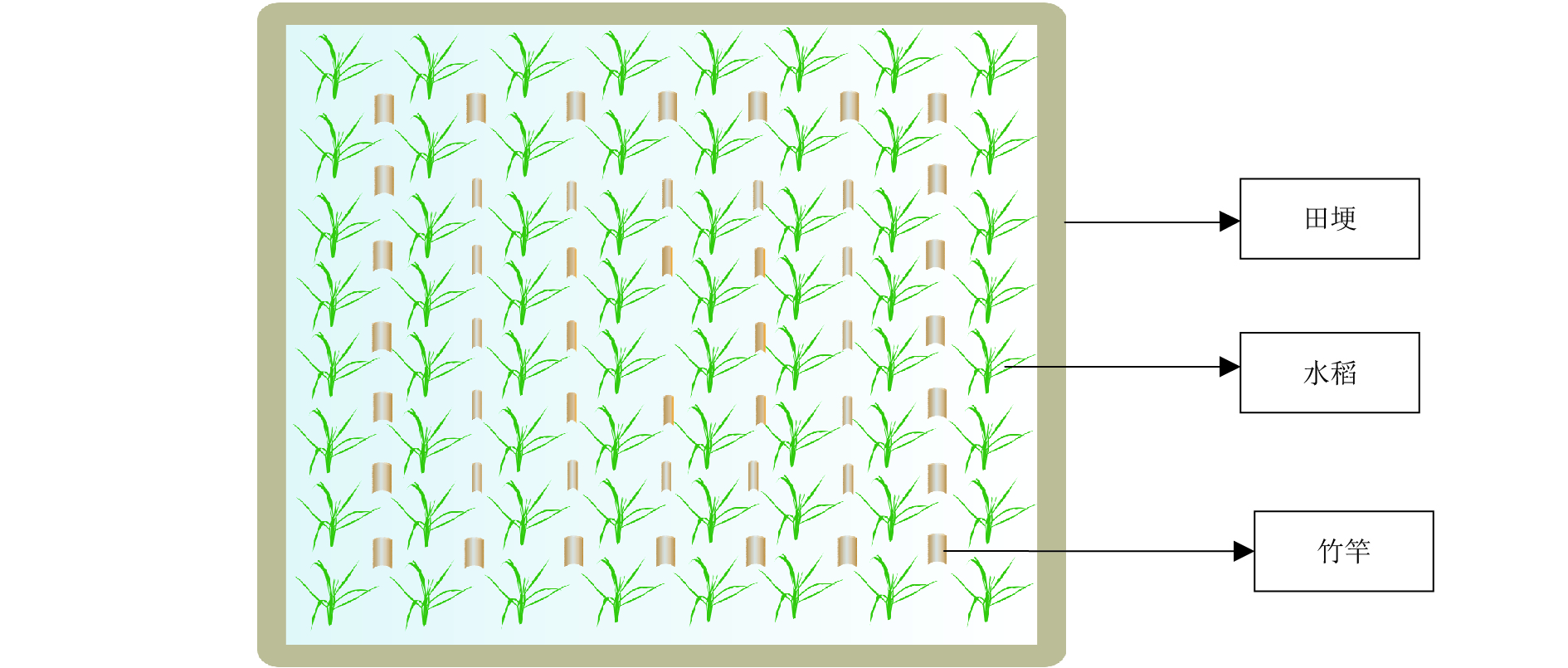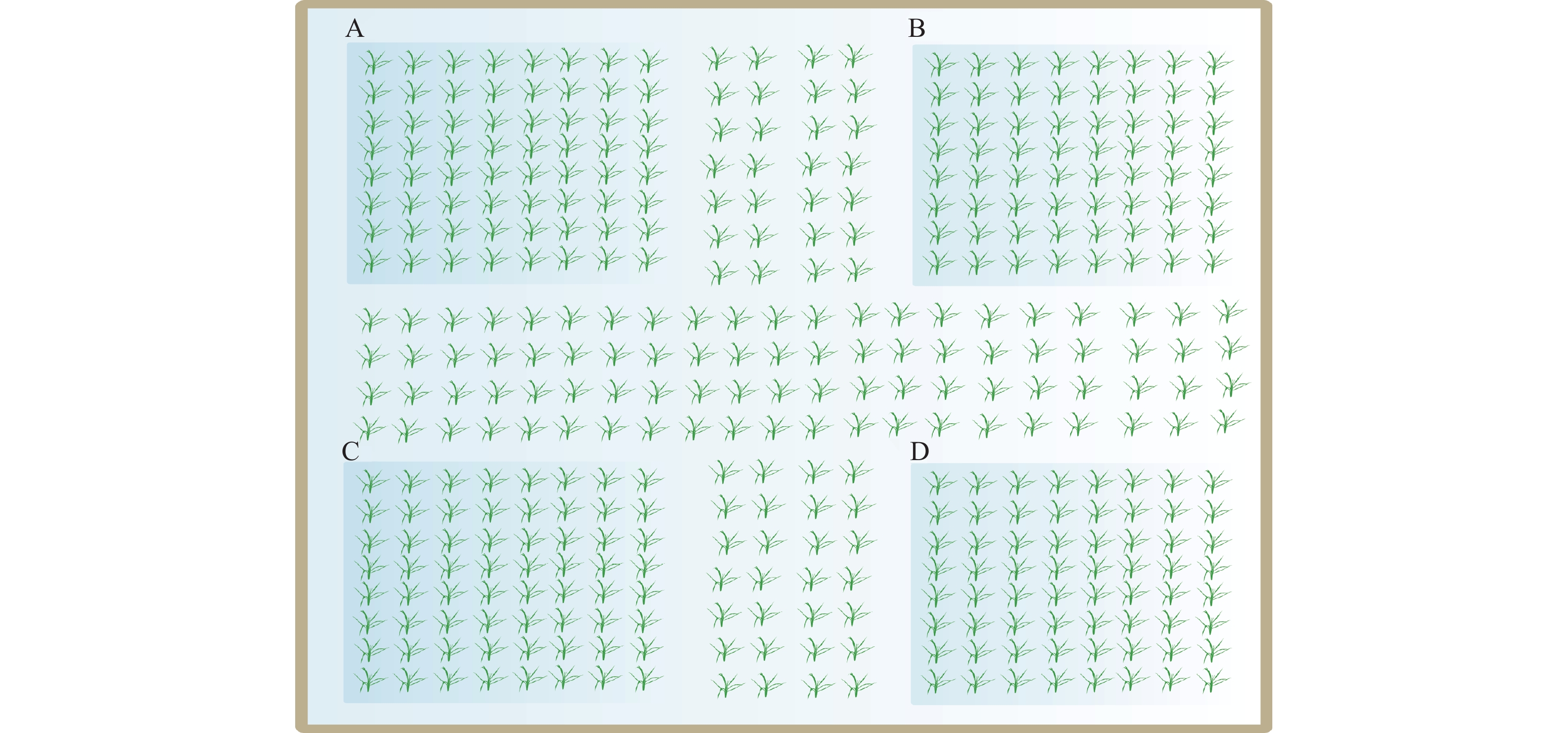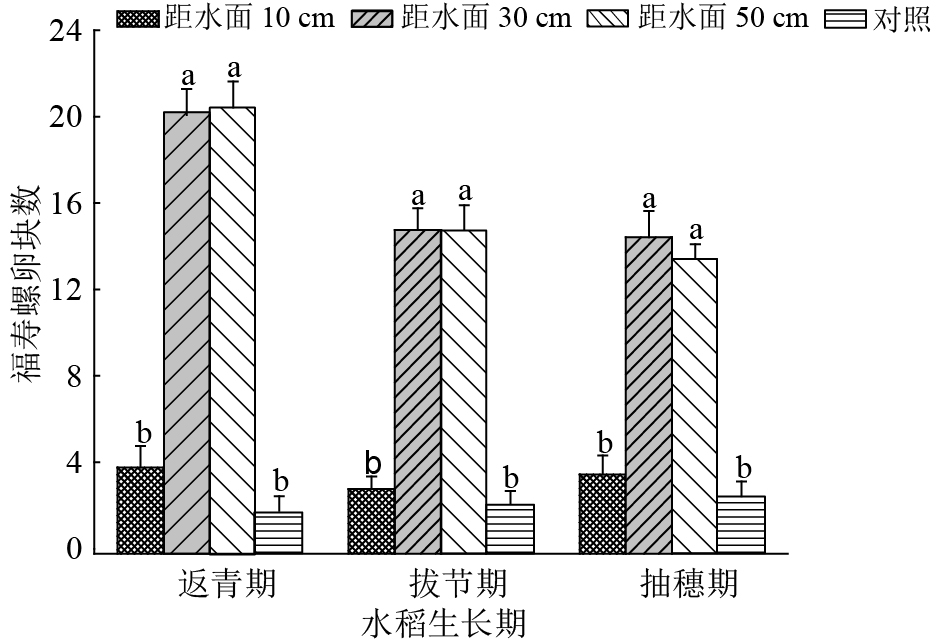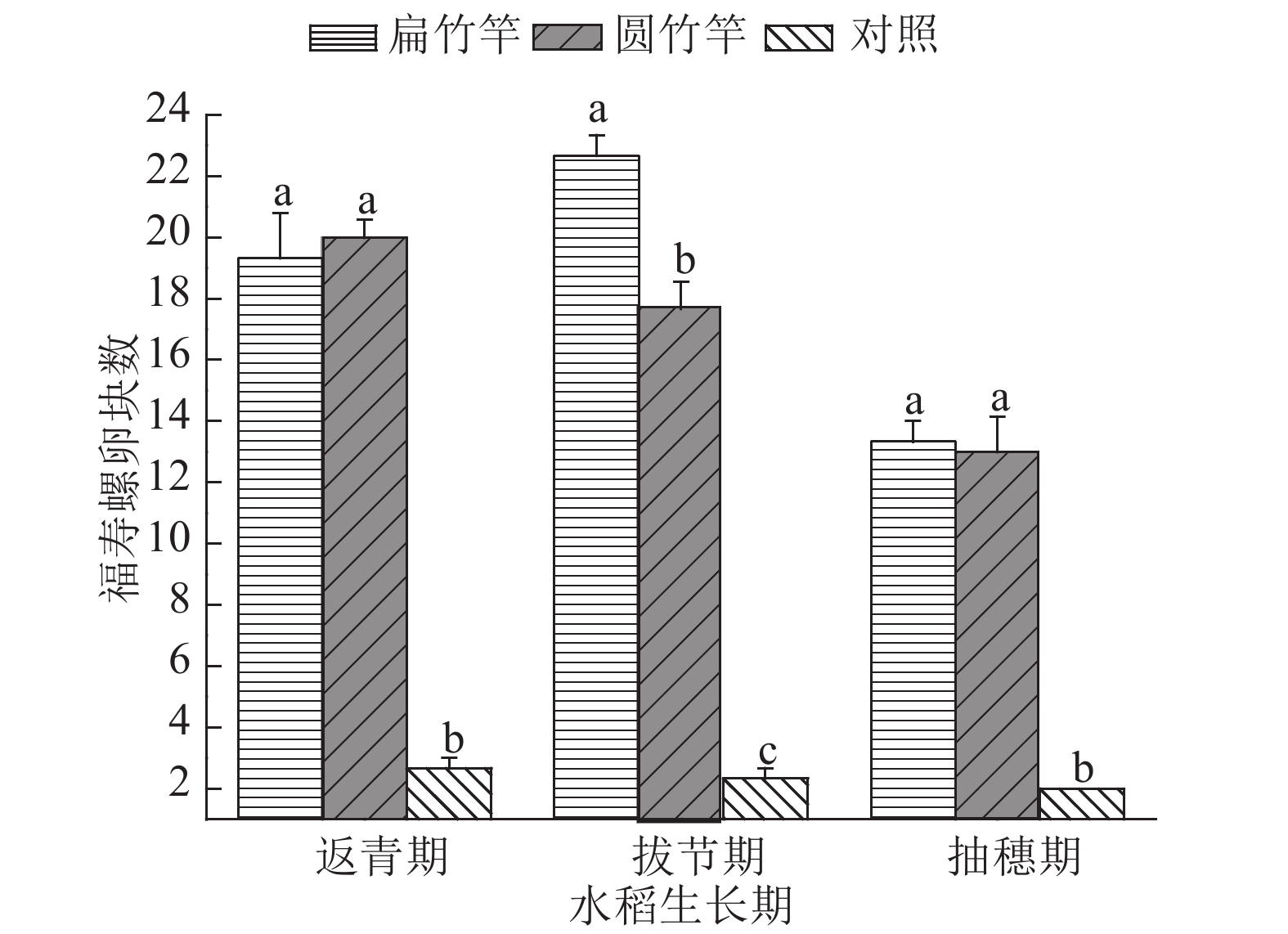Trapping effect of inserting bamboo poles in the paddy fields on spawning of Pomacea canaliculata
-
摘要:目的
研究田间不同插竿方式对福寿螺Pomacea canaliculata产卵的影响。
方法通过插竿位置、插竿间距、插竿高度及竹竿形状4个因素研究不同的插竿方式对福寿螺产卵的诱集效率。
结果稻田插竹竿能诱集福寿螺在其上产卵,且在竹竿上收集到的福寿螺卵块数量呈现返青期>拔节期>抽穗期的变化趋势。在效果最明显的返青期,距离田埂1 m的竹竿对螺卵诱集效率达到50%以上,显著高于其他位置竹竿及对照水稻茎秆上的卵块数(P<0.05);距离田埂2 m的竹竿次之,距离田埂3 m的竹竿和对照最少。间距100 cm的竹竿诱集螺卵效率为41%,间距30 cm的为33%,显著高于间距70 cm及未插竹竿区域内水稻茎秆上的卵块数(P<0.05)。顶端距离水面高度30 cm的竹竿与距离水面高度50 cm的竹竿诱集产卵效率分别为43%和40%,显著高于高度10 cm及未插竹竿区域内水稻茎秆上的卵块数(P<0.05)。圆形竹条与扁竹竿在此时期收集得到的卵块数无显著差异。水稻移栽后,在靠近田埂1 m处和顶端距离水面30~50 cm的高度扦插1圈间距为100 cm的竹竿,在福寿螺为害盛期,螺卵发生密集的小范围区域内减小间距为30 cm沿田埂内周扦插1圈竹竿,均能达到较好的螺卵防除效果。
结论实际生产中在田间合理地扦插竹竿可有效减少福寿螺卵块,降低福寿螺繁殖率,减少螺害。本研究可为物理控螺提供一条新的有效途径。
Abstract:ObjectiveTo study different methods of inserting bamboo poles in paddy field on spawning ofPomacea canaliculata.
MethodEffects of four factors including position, distance, height and shape of inserting poles on trapping efficiency of P. canaliculata spawning were investigated.
ResultThe bamboo poles inserted in paddy field could lure P. canaliculata to spawn on them. The number of egg masses tended to decrease successively from reviving stage, jointing stage to heading stage. At reviving stage with the best trapping effect, more than 50% egg masses were found on the bamboo poles which were 1 m from the paddy ridge, and the number was significantly higher compared with bamboo poles at other positions and rice straws(control)(P<0.05). The bamboo poles at 3 m distance from the paddy ridge and rice straws had the least numbers of egg masses, followed by the bamboo poles at 2 m distance from the paddy ridge. The trapping efficiencies for bamboo pole layouts with 100 cm distance and 30 cm distance between poles were 41% and 33% respectively, which were significantly higher than those for bamboo pole layout with 70 cm distance between poles and the control (P<0.05). The trapping efficiencies for bamboo poles with the tops being 30 and 50 cm high above water surface were 43% and 40% respectively, which were significantly higher than those for bamboo poles with the tops being 10 cm high above water surface and the control (P<0.05). There was no significant difference in the numbers of egg masses between circular-shaped and flat-shaped bamboo poles. After transplanting the rice, high trapping efficiency ofP. canaliculata spawning could be obtained by inserting bamboo poles at 1 m distance from paddy ridge, with 100 cm distance between poles and the tops being 30–50 cm high above water surface. Specially, at peak attack period ofP. canaliculata, bamboo poles inserted at 30 cm distance between poles could realize efficient trapping of egg masses.
ConclusionAppropriately inserting bamboo poles in paddy field can help reduce the egg mass of P. canaliculata, hence reduce the reproductive rate of P. canaliculata and decrease the harm of P. canaliculata in practice. This research provides a new physical control approach of P. canaliculata.
-
-
-
[1] HALWART M. The golden apple snail Pomacea canaliculata in Asian rice farming systems: Present impact and future threat[J]. Int J Pest Manage, 1994, 40(2): 199-206.
[2] YOSHIE H, YUSA Y. Effects of predation on the exotic freshwater snail Pomacea canaliculata (Caenogastropoda: Ampullariidae) by the indigenous turtle Chinemys reevesii(Testudines: Geoemydidae)[J]. Appl Entomol Zool, 2008, 43(4): 475-482.
[3] YUSA Y, WADA T. Impact of the introduction of apple snails and their control in Japan[J]. Naga: The IC LARM Quarterly, 1999, 22(3): 9-13.
[4] 潘长旺, 凌洪博, 梁韶晖, 等. 温州地区广州管圆线虫病的临床及流行病学研究[J]. 中华医学杂志, 2000, 80(3): 204-205. [5] LOWE S, BROWNE M, BOUDJELAS S, et al. 100 of the world’s worst invasive alien species: A selection from the global invasive species database[M]. Auckland, New Zealand: Invasive Species Specialist Group. 2000.
[6] 叶建人, 李云明. 福寿螺在水稻田的消长规律及其田间分布动态[J]. 中国农学通报, 2009, 25(3): 185-188. [7] 俞小平, 和田节, 顾中方, 等. 稻田福寿螺的发生和治理[J]. 浙江农业学报, 2001, 13(5): 247-252. [8] 王志高, 谭继才, 刘军, 等. 福寿螺综合防治研究进展[J]. 中国农学通报, 2009, 25(12): 201-205. [9] CHENG E, KAO C. Control of golden apple snail, Pomacea canaliculata (Lamarck), in Taiwan[J]. Phil Rice, 2006: 155-167.
[10] 陶红群, 贾滨洋, 张峰瑜, 等. 成都市境内外来物种福寿螺的危害现状调查及防治措施分析[J]. 四川环境, 2005, 24(3): 108-110. [11] ITO K. Environmental factors influencing over wintering success of the golden apple snail, Pomacea canaliculata (Gastropoda: Ampullariidae), in the northernmost population of Japan[J]. Appl Entomol Zool, 2002, 37(4): 655-661.
[12] 周外, 刀学琼, 邓才明, 等. 福寿螺的繁殖与生长研究[J]. 安徽农业科学, 2015, 43(11): 134-135. [13] 段清星, 李湘, 王本君, 等. 福寿螺密度变化的环境影响因素研究[J]. 四川动物, 2016, 35(4): 503-510. [14] 董朝莉. 福寿螺的生物生态学特性及在广西的分布与危害现状研究[D]. 桂林: 广西师范大学, 2006. [15] WANG Z, TAN J, TAN L, et al. Control the egg hatchling process of Pomacea canaliculata (Lamarck) by water spraying and submersion[J]. Acta Ecologica Sinica, 2012, 32(4): 184-188.
[16] FRASSA M V, CEOLIN M, DREON M S, et al. Structure and stability of the neurotoxin PV2 from the eggs of the apple snail Pomacea canaliculata[J]. Biochim Biophys Acta, 2010, 1804(7): 1492-1499.
[17] SEUFFERT M E, MARTÍN P R. Distribution of the apple snail Pomacea canaliculata in Pampean streams (Argentina) at different spatial scales[J]. Limnologica, 2013, 43(2): 91-99.
[18] 朱丽霞, 黄瑶瑶, 张泽宏, 等. pH, 食物和光周期对福寿螺生长发育和繁殖的影响[J]. 生态学报, 2015, 35(8): 2644-2651. [19] SEUFFERT M. A lentic dweller in lotic habitats: The behavior of the invasive South American apple snail Pomacea canaliculata in flowing water[J]. Aquat Ecol, 2012, 46(1): 129-142.
[20] HARA A, HAMASAKI K, YOSHIDA K, et al. Canal type affects invasiveness of the apple snail Pomacea canaliculata through its effects on animal species richness and waterweed invasion[J]. Biol Invasions, 2015, 17(1): 63-71.
[21] 鲁艳辉, 高广春, 郑许松, 等. 诱集植物香根草对二化螟幼虫致死的作用机制[J]. 中国农业科学, 2017, 50(3): 486-495. [22] 李凯利, 高景鹏, 曹杰, 等. 3种植物浸液对白纹伊蚊产卵的影响研究[J]. 中国媒介生物学及控制杂志, 2017, 28(1): 4-8. [23] 王文龙, 任利利, 张连生, 等. 不同波长LED灯对油松毛虫的诱捕效果与评价[J]. 应用昆虫学报, 2017, 54(6): 955-960. [24] 陈水呇. 松诱木设置对松墨天牛诱集效果的影响[J]. 青海农林科技, 2016, 2: 30-32. [25] 毛琦, 朱豪红, 党绍东, 等. 稻田福寿螺空间分布型和抽样技术的研究[J]. 广西植保, 2011, 24(1): 11-15. [26] 贤振华, 覃荣乐, 冷付春, 等. 稻田福寿螺为害程度上升原因分析及防控策略[J]. 广西农业科学, 2009, 40(8): 1007-1009. [27] ESTEBENET A L, MARTIN P R. Pomacea canaliculata (Gastropoda: Ampullaridae): Life- history traits and their plasticity[J]. Biocell, 2002, 26(1): 83-89.
[28] 杨爱娟, 谭济才, 袁哲明, 等. 福寿螺产卵高度与克氏原螯虾捕食卵块的研究[J]. 中国农学通报, 2012, 28(8): 90-93. [29] JOSHI R C, VREYSEN M J B, ROBINSON A S, et al. Problems with the management of the golden apple snail Pomacea canaliculata: An important exotic pest of rice in Asia[M]//RAVINDRA C J. Area-wide control of insect pests: From research to field implementation. Berlin: Springer Netherlands, 2007: 257-264.
[30] 刘军, 何跃进, 谭济才, 等. 自然条件下福寿螺繁殖特性[J]. 应用生态学报, 2012, 23(2): 559-565.




 下载:
下载:





